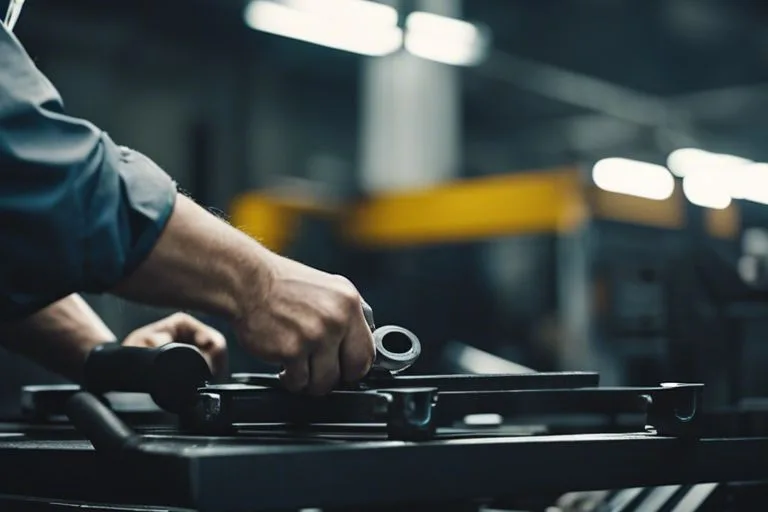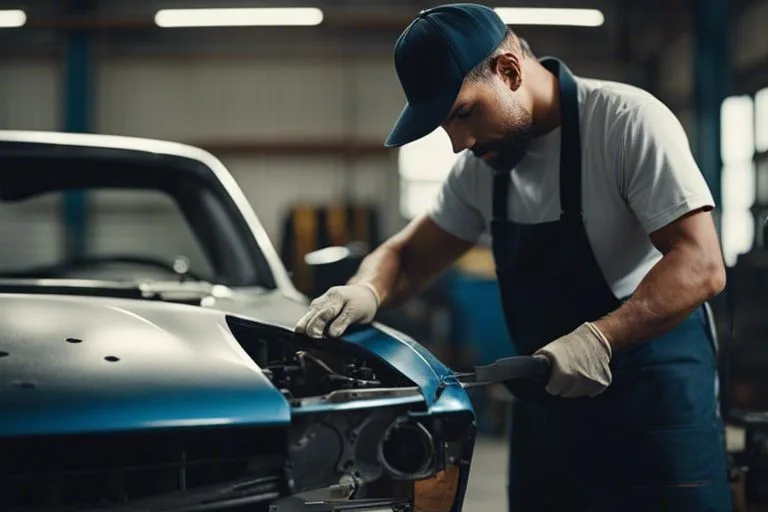Importance of ensuring that proper frame straightening techniques are used cannot be overstated in the world of auto body repair. From preserving structural integrity to ensuring safety on the road, precision and expertise are key when it comes to aligning vehicle frames. Let’s explore the significance of this critical process and how it can impact the overall quality of repairs.

Key Takeaways:
- Proper frame straightening techniques are crucial for ensuring the structural integrity and safety of a vehicle.
- Using advanced tools and equipment can help achieve accurate and precise frame alignment during repairs.
- Seeking professional assistance from trained technicians is recommended to avoid long-term issues related to improper frame straightening.
Vehicle Safety Assurance
Passenger Protection
A crucial aspect of proper frame straightening techniques is ensuring passenger protection. Little can be as important as the safety of those inside a vehicle. Correctly aligning the frame ensures that in the event of a collision, the structural integrity of the vehicle can effectively absorb and distribute impact forces, minimizing the risk of injury to those inside.
Chassis Integrity
Even minor misalignments in the chassis can compromise the overall integrity and safety of a vehicle. The chassis serves as the backbone of the vehicle, providing stability and support to all its components. When the chassis is not properly straightened, it can lead to handling issues, decreased stability, and potentially hazardous driving conditions.
Plus, a misaligned chassis can affect the alignment of other crucial components such as the suspension system and steering mechanism. This can result in uneven tire wear, decreased fuel efficiency, and overall diminished performance of the vehicle.
Cost-Effectiveness
Long-term savings
One of the key benefits of proper frame straightening techniques is the long-term savings it can provide. By ensuring that the frame is correctly aligned, you can prevent issues such as uneven tire wear, alignment problems, and other costly repairs down the line.
Reduced repair frequency
With proper frame straightening, you can significantly reduce the frequency of repairs needed on your vehicle. When the frame is not straightened correctly, it can cause stress on other components of the vehicle, leading to more frequent breakdowns and repairs.
Resale Value Preservation
Aesthetic Appeal Maintenance
Keep your vehicle’s resale value high by ensuring proper frame straightening techniques are used. Aesthetic appeal plays a significant role in determining the value of a vehicle, and any signs of damage or misalignment can greatly decrease its worth. By straightening the frame correctly, you not only restore the look of the vehicle but also maintain its value for future resale.
Structural Integrity Documentation
You should always prioritize documenting the structural integrity of your vehicle after frame straightening. This documentation serves as proof that the necessary repairs have been completed properly and can provide peace of mind to future buyers. By having detailed records of the structural integrity post-repair, you not only ensure the safety of the vehicle but also enhance its market value.
Appeal to potential buyers by showcasing the meticulous documentation of the frame straightening process. This documentation not only demonstrates the care taken in repairing the vehicle but also provides transparency regarding its structural integrity. Buyers will appreciate the detailed records, which can instill confidence in the quality and reliability of the vehicle.
For instance, having before-and-after photos of the frame straightening process, along with any certification of the repairs, can significantly enhance the credibility of the vehicle’s structural integrity. These documents can act as a selling point when negotiating the resale value of the vehicle, making it a worthwhile investment to properly document the frame straightening procedures.
Precise Alignment Necessity
Proper wheel alignment
Now, the first step in proper frame straightening techniques is ensuring precise wheel alignment. Assuming the wheels are not aligned correctly, it can lead to uneven tire wear, steering difficulties, and even decreased fuel efficiency. It is crucial to use advanced alignment equipment to accurately measure and adjust the angles of the wheels to ensure they are parallel to each other and perpendicular to the ground.
Enhanced driving control
Some may underestimate the importance of precise alignment in achieving enhanced driving control. It is necessary for steering stability, balanced tire performance, and overall vehicle safety. Proper alignment ensures that the vehicle responds predictably to steering input, improving driver confidence and reducing the risk of accidents.
It is crucial to understand that precise alignment goes beyond just the wheels. It involves straightening the frame to ensure that all components are properly positioned and functioning correctly. This meticulous process not only enhances driving control but also prolongs the lifespan of the vehicle’s suspension system and tires.
Warranty Compliance
Manufacturer standards adherence
After a vehicle has been involved in a collision, it is crucial to ensure that the frame straightening is done in accordance with the manufacturer’s standards. Failure to adhere to these specific guidelines can result in voiding the vehicle’s warranty.
Coverage eligibility retention
To maintain coverage eligibility for the vehicle’s warranty, it is imperative to follow the recommended standards for frame straightening. Failure to do so may lead to the denial of warranty claims related to the frame or structural components of the vehicle.
It is important to note that each vehicle manufacturer has their own set of standards for frame straightening techniques. By following these guidelines, vehicle owners can ensure that their warranty coverage remains intact in case of any future issues related to the vehicle’s frame.
Collision Impact Analysis
Damage Assessment Accuracy
For any proper frame straightening process, damage assessment accuracy is crucial. Using advanced tools and techniques, technicians can accurately identify the extent of structural damage caused by a collision. This ensures that the repair strategy is tailored specifically to the needs of the vehicle, preventing any further issues down the line.
Repair Strategy Optimization
Impact analysis plays a key role in optimizing the repair strategy for a frame straightening process. By carefully evaluating the collision impact and structural damage, technicians can determine the most effective and efficient way to straighten the frame. This not only saves time but also ensures that the structural integrity of the vehicle is fully restored.
Plus, by optimizing the repair strategy, technicians can minimize any potential risks or complications that may arise during the frame straightening process. This helps guarantee the quality and longevity of the repair, providing peace of mind to both the technician and the vehicle owner.
Legal and Regulatory Adherence
Road safety regulations
Assuming the responsibility of straightening a vehicle’s frame goes beyond just the technical aspect; it also involves adherence to road safety regulations. Proper frame straightening techniques are imperative to ensure the structural integrity of the vehicle, which directly impacts the safety of the driver, passengers, and other road users. Failure to comply with these regulations can result in legal repercussions and jeopardize lives on the road.
Insurance company requirements
Clearly, insurance companies have strict requirements when it comes to frame straightening, as it is a crucial component in the repair process. Insurance policies often mandate that frame straightening is performed by certified technicians using approved methods and equipment. This ensures the quality of the repair work and helps prevent any future safety issues related to the vehicle’s structure.
In addition to following insurance company requirements, it is imperative for your own safety and the safety of others on the road that proper frame straightening techniques are employed. The frame of a vehicle plays a critical role in its overall structural integrity, and any compromise in this area can have serious consequences in the event of a collision.
Technological Adaptation
Modern equipment usage
Many automotive repair shops have embraced modern technology in their frame straightening processes. Assuming the importance of precision and efficiency, they utilize specialized equipment such as computerized measuring systems and hydraulic presses to ensure accurate alignment of vehicle frames.
Advanced technique implementation
Clearly, advanced frame straightening techniques go beyond just the use of modern equipment. This involves the implementation of cutting-edge methods that require specialized training and expertise.
- Computerized measuring systems: Allow for precise measurements and analysis of frame alignment.
- Hydraulic presses: Apply controlled pressure to manipulate and straighten frame structures.
This level of advancement in frame straightening techniques ensures that vehicles are restored to their original structural integrity, meeting safety and performance standards.
Final Words
From above, it is clear that proper frame straightening techniques are crucial for ensuring the safety, performance, and longevity of a vehicle. Using the correct tools, equipment, and methods is crucial to restore the structural integrity of the frame and prevent future issues. By following industry standards and guidelines, auto body professionals can guarantee that the vehicle is repaired correctly and meets safety standards. Neglecting proper frame straightening techniques can result in compromised safety, alignment issues, and overall poor vehicle performance. It is imperative for technicians to continuously improve their skills and stay updated on the latest advancements in frame straightening technology to provide the best service to their customers. Ultimately, investing time and effort into mastering proper frame straightening techniques is crucial for delivering high-quality and reliable auto body repairs.
FAQ
Q: What is the importance of proper frame straightening techniques?
A: Proper frame straightening techniques are crucial in ensuring the structural integrity and safety of a vehicle. Accurate alignment of the frame is imperative for the vehicle to perform correctly and protect occupants in the event of a collision. Using the right methods and equipment helps maintain the original factory specifications and ensures the vehicle’s overall stability.
Q: How can improper frame straightening techniques affect a vehicle?
A: Improper frame straightening techniques can lead to a range of issues, including misaligned components, uneven weight distribution, handling problems, and safety hazards. Failing to correct the frame alignment properly can result in premature wear and tear on tires, suspension, and other critical parts. This can compromise the vehicle’s performance and increase the risk of accidents.
Q: What are some common methods used for proper frame straightening?
A: Some common methods for proper frame straightening include using computerized measuring systems, hydraulic rams, and frame pulling equipment. These tools help technicians assess the extent of damage, accurately measure alignment, and apply controlled force to straighten the frame back to its original shape. By following manufacturer specifications and guidelines, technicians can ensure that the frame is restored correctly.

